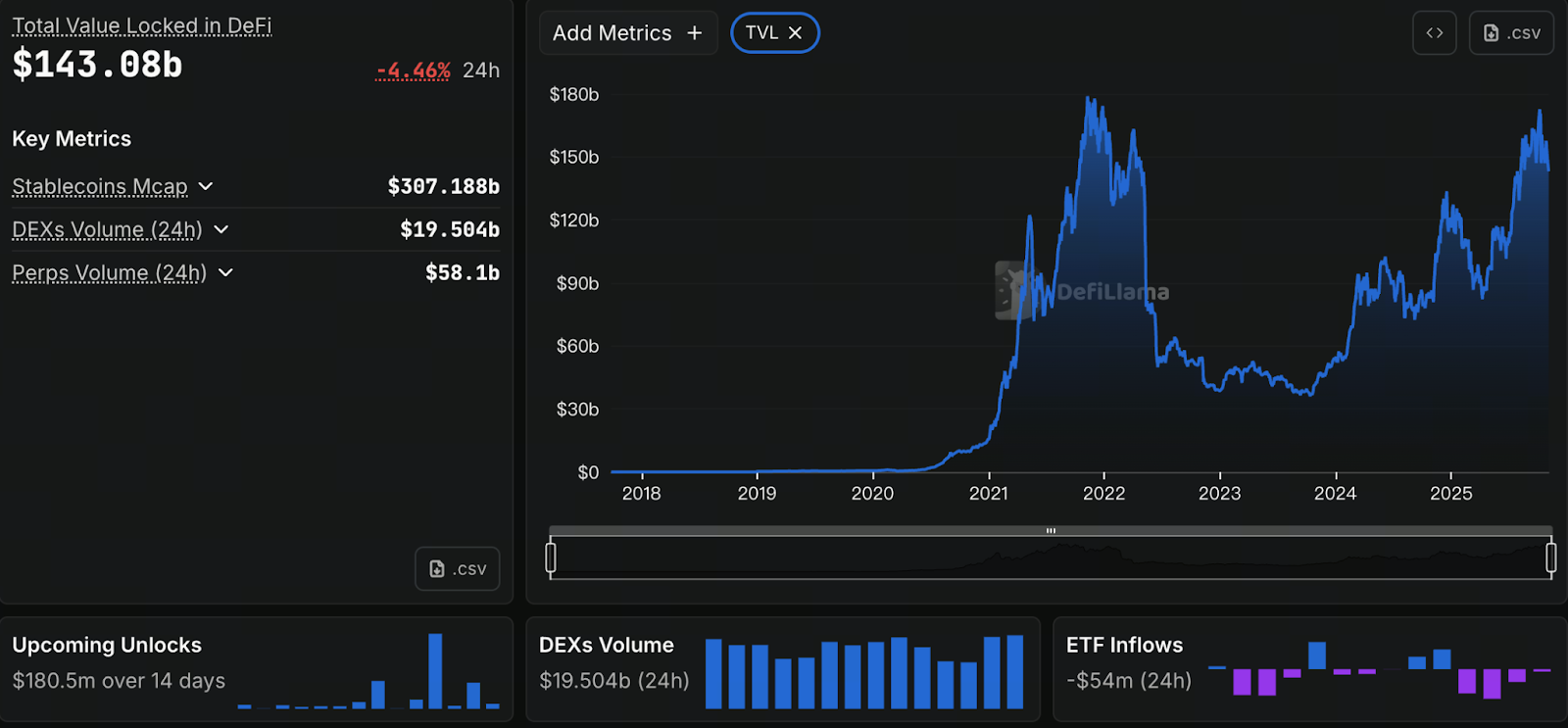TVL Rebounds: Why Capital Is Flowing Back Into DeFi in Fall/Winter 2025
What Is TVL? Why Should You Track It?
TVL (Total Value Locked) measures both the liquidity and activity within the DeFi ecosystem. It reflects the total dollar value of assets locked in smart contracts. Rising TVL typically signals increased capital flowing into decentralized lending, liquidity pools, staking, and other on-chain services. This makes it a crucial indicator for monitoring capital movement and gauging market sentiment.
Latest Data

Source: https://defillama.com/
Live aggregate data shows that, at the time of writing, DeFiLlama’s dashboard reports a total value locked of approximately $142.10 billion. This is based on their “real-time snapshot” methodology. Quarterly reports and independent research sources, in contrast, cite $156–$170 billion for Q3 2025 or end of September, focusing on quarterly growth and macro trends. Methodologies vary in whether they include bridged assets and in their approach to stablecoin valuation.
Three Key Drivers of Capital Returning to DeFi
- Layer2 Scaling Reduces Costs: The maturity of Layer2 solutions—such as Arbitrum, Base, and Optimism—has lowered transaction fees and transaction confirmation times, attracting smaller users and DEX liquidity providers to move on-chain, leading to incremental TVL growth. The L2 TVL metric has continued to climb in 2025 and is now the primary pathway for capital movement.
- RWA (Real World Assets) Bring Institutional Capital: Projects that tokenize bonds, notes, and real estate income streams are drawing in institutional investors seeking stable returns. While still a growing segment, their contribution to overall TVL is already substantial.
- Yield Reuse and Restaking: Restaking and liquid staking tokens (LSTs) enable the same asset to generate yield across multiple platforms, temporarily inflating TVL figures in the short term. It’s important to distinguish between reported TVL and actual economic capital at risk.
How to Use TVL as a Beginner
- Track Trends, Not Just Totals: Real-time dashboards can be volatile; review 7-day, 30-day, and quarterly trends for clearer direction.
- Segment by Chain/Protocol: Monitor Ethereum’s share, Layer2 growth, and changes in TVL for RWA and lending protocols to understand capital inflows and outflows.
- Watch for Security Incidents: Major protocol exploits can trigger sharp, temporary TVL drops (as seen in recent attacks), which underscores the importance of prioritizing security.
Risk Considerations and Final Thoughts
TVL is a valuable signal, but it’s not a comprehensive indicator: Methodological differences, liquidity reuse through restaking, and double-counting of bridged assets may inflate TVL numbers. When analyzing, always note the data source, methodology, and reporting period. For more reliable insights, consider TVL alongside price, trading volume, and active addresses.
Related Articles

2025 BTC Price Prediction: BTC Trend Forecast Based on Technical and Macroeconomic Data

Flare Crypto Explained: What Is Flare Network and Why It Matters in 2025

Pi Coin Transaction Guide: How to Transfer to Gate.com

How to Use a Crypto Whale Tracker: Top Tool Recommendation for 2025 to Follow Whale Moves

What is N2: An AI-Driven Layer 2 Solution


